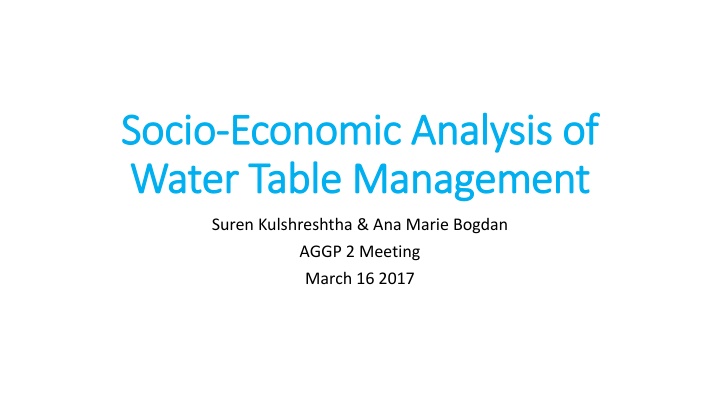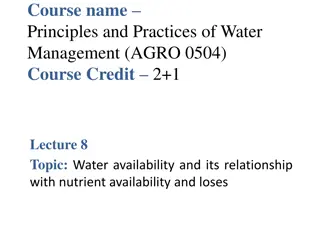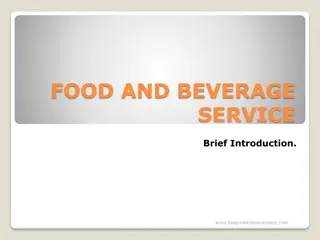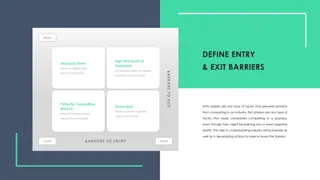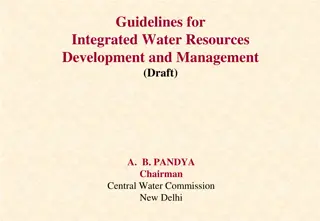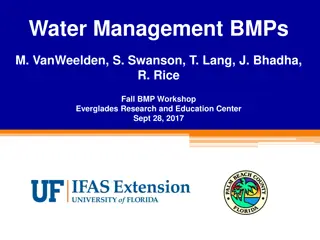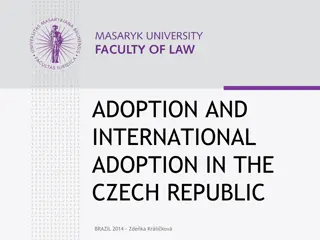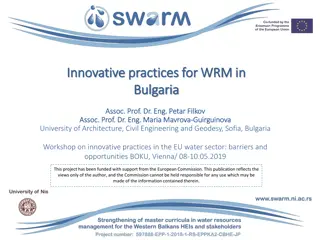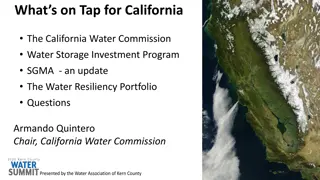Economic Analysis of Water Table Management: Insights and Barriers to Adoption
An overview of the socio-economic analysis of water table management in agricultural practices, including major findings from field studies, barriers to adoption, and factors influencing the adoption of Best Management Practices (BMPs) among producers. The study highlights the economic motivations, challenges, and considerations affecting the implementation of new technologies in farming practices.
Download Presentation

Please find below an Image/Link to download the presentation.
The content on the website is provided AS IS for your information and personal use only. It may not be sold, licensed, or shared on other websites without obtaining consent from the author.If you encounter any issues during the download, it is possible that the publisher has removed the file from their server.
You are allowed to download the files provided on this website for personal or commercial use, subject to the condition that they are used lawfully. All files are the property of their respective owners.
The content on the website is provided AS IS for your information and personal use only. It may not be sold, licensed, or shared on other websites without obtaining consent from the author.
E N D
Presentation Transcript
Socio Socio- -Economic Analysis of Economic Analysis of Water Table Management Water Table Management Suren Kulshreshtha & Ana Marie Bogdan AGGP 2 Meeting March 16 2017
AGGP AGGP 1 Activities: Location 1 Activities: Location Location Enterprise Scope/Treatment ST. Emmanuel Corn Controlled Tile Drainage with Sub-irrigation vs Field Drainage Harrow Corn Same as above (analysis not complete) Leamington Tomatoes Surface and sub-surface drip irrigation St. Louis de Blandford Cranberries Water table vs. No water table Sherrington Onion sprinkler irrigation and sprinkler irrigation using tensiometer for irrigation scheduling Drainage vs. Sub-irrigation and drainage Truro Dairy (Milk) production
Major findings AGGP1 (1) Major findings AGGP1 (1) All treatments included in AGGP1 resulted in gain in benefits to the producers These results were based on a single farm case study in most cases; no consideration made to size differences, or other physical characteristics of the farm Famers indicated that their adoption of these new practices would be affected by their own economic outcomes, even when the environmental and social considerations appear as motivation Economic motivation included: increased yields, protability of investment, being able to try the technology, reduce labor costs, reduce water use
AGGP1: Barriers to adoption AGGP1: Barriers to adoption Tight profit margins and uncertainty related to future contracts Financial requirements Perceptions of the new technology affects its adoption If the perception is beneficial, adoption is more likely Perception of a new technology is affected by factors: goals of the producer, education level, farming experience, specialization in the crop affected by the technology, and the degree to which it benefis the society as a whole
AGGP1: Adoption of BMPs AGGP1: Adoption of BMPs Data from 70 producers were collected Significant factors included: education level, farm size, positive attitude re. environment, perception of the BMP, and goals of the producers Most significant factors: perception of producers, advantage provided by new technology over the existing one
AGGP1: Lessons learnt AGGP1: Lessons learnt Web-Based surveys led to low response rate, and skewed the sample to larger farms Developing early connections with information gate-keepers is essential How perceptions are formed is a relatively unknown area Non-adopters have some misconception of the new technology, which can be changed through proper policy measures Open-ended and qualitative questions provide in-depth information on the adoption decision-making process Face-to-face interviews provide better response rate
AGGP1: Recommendations AGGP1: Recommendations Data collection should be comprehensive and consistent with the type of analysis planned Experimental design should be selected in collaboration with farmers, all members of the research team, and regional experts
AGGP AGGP 2: Location 2: Location Location Enterprise Scope/Treatment AGGP2 ST. Emmanuel Corn Controlled Tile Drainage with Sub- irrigation vs Field Drainage Yes Harrow Corn Same as above (analysis not complete) Yes Sherrington Onion Yes Truro Dairy (Milk) production Drainage vs. Sub-irrigation and drainage Yes Boulden, NS New Site Holland Marsh New Site Ste. Anne-de-Bellevue New Site
AGGP2: Overview AGGP2: Overview Develop information and policy measures that would ensure adoption of project developed new technologies Three major milestones 1. Collection of farm level data 2. Robust economic and environmental evaluation of beneficial water management systems 3. Analysis of socio-economic data
Milestone 1: Socio Milestone 1: Socio- -economic Data Gathering economic Data Gathering Four seasons of farm level data collection, one each for 2017-18, 2018-19, 2019-20, and 2020-21 To include economic characteristics of the technology Farm level characteristics Survey of farmers using a questionnaire
Milestone 2: Robust economic and environmental Milestone 2: Robust economic and environmental evaluation of beneficial water management evaluation of beneficial water management systems systems Whole Farm Level Simulation model for private economics of technology Model with several different characteristics (Size, Specialization, Alternative technology) Sensitivity analysis of economics Farmers and stakeholder workshops Life Cycle analysis modeling Multi-criteria analysis modeling
Life Cycle Analysis Life Cycle Analysis Scope of this analysis is from Cradle-to-grave for the new technology All inputs needed for the implementation of the technology and all related activities are included Emphasis would be on aspects realted to environmental goods and services Carbon stock change as a result of adoption of the technology would also be included Undertaking Life Cycle Analysis using alternative methods would be explored
Multi Multi- -criteria Analysis criteria Analysis Refers to decision making using various alternatives and different goals of the decision maker Decision making criteria could also be different Some of the goas may be conflicting in nature and may requires some trade-offs Incorporates both qualitative and quantitative information Different options area ranked according to the given set of objectives (goals) Three types of indicators: Financial, Social and Ecological.
Milestone 3: Analyze socio Milestone 3: Analyze socio- -economic economic data Industry profiles Analysis of questionnaires Regression analysis re adoption factors, barriers, and perception Identification of key factors in the diffusion of improved practices Identification of factors influencing adoption Barriers to adoption Comparison of adopters and non-adopters Estimation of non-market benefits, both market-based and non-market based Estimation of regional socio-economic and environmental effects of Estimation of adoption potential of said technology Introduction of climate change Estimation of total carbon sequestration Policy review and assessment
